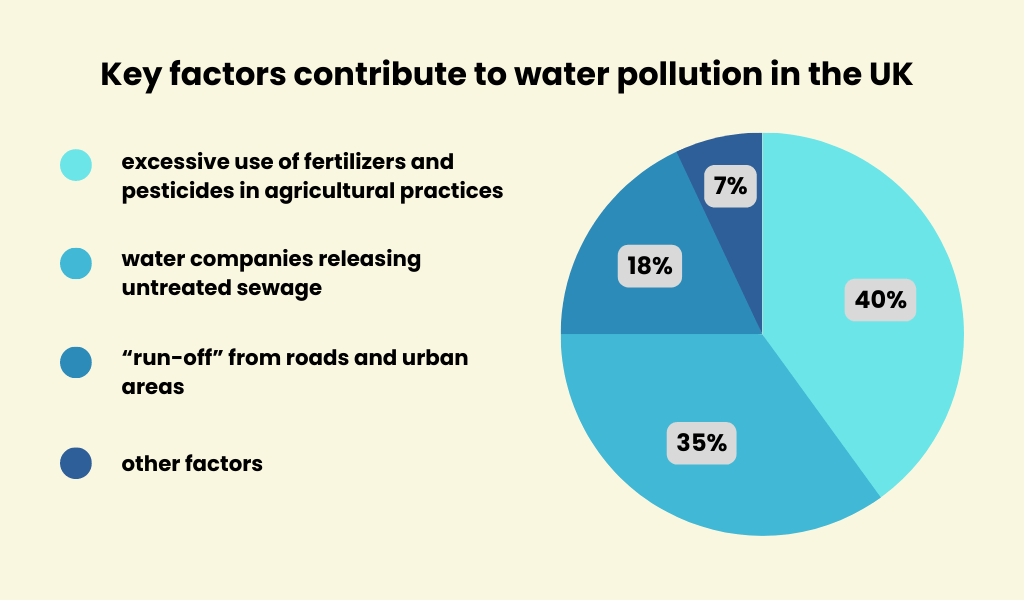Thames Water has received a fine of £3.3 million due to its actions of releasing undiluted sewage into rivers
near Gatwick Airport in 2017. This reckless incident resulted in the death of over 1,000 fish and caused the
water to turn black.
This is not the first time Thames Water has faced penalties for pollution spillage, as they have been fined 20
times previously. The recent fine adds to the growing concerns about the water quality, while the company serves
15 million households in London and the Thames Valley.
Why is sewage pumped into rivers and the sea?
In the UK, a majority of areas utilize a combined sewerage system, where rainwater and wastewater from toilets,
bathrooms, and kitchens are carried through the same pipes. Under normal circumstances, all waste is transported
to a sewage treatment works for proper processing. However, during periods of heavy rainfall, particularly when
the ground is unable to absorb water quickly, the capacity of the system can be exceeded.
This can result in the overwhelming of sewage works and the potential flooding of homes, roads, and open spaces.
To address this issue, the system is designed to occasionally overflow and release excess wastewater into rivers
and the sea. This practice, known as combined sewer overflows (CSOs), is permitted as a means to prevent
overwhelming the system and causing further damage.
The Environment Agency (EA), responsible for overseeing environmental protection in England, requires water
companies to monitor these overflows. If companies fail to meet certain requirements, they can be investigated
and face fines. The aim is to ensure that the overflows are properly managed and regulated to minimize the
impact on the environment and public health.
How often is sewage released?
In 2022, there was a significant occurrence of raw sewage being discharged into rivers and seas, totaling 1.75
million hours of release. On average, this equated to approximately
825 discharges per day. Unfortunately, this
untreated effluent contains various harmful substances such as human waste, wet wipes, and sanitary products,
which pose a severe risk to the local wildlife, swimmers, and anyone utilizing the waterways in the UK.
This activity not only degrades precious ecosystems but also poses a direct danger to public health. Professor
Jamie Woodward, a geography professor at the University of Manchester, emphasizes the detrimental impact,
stating, "Each discharge represents a toxic combination of numerous pollutants, including microplastics and
pathogens." Such contamination poses a significant threat to the environment and the well-being of individuals
exposed to these polluted water sources.
How clean are UK waters?
The sewerage system in the UK is currently in a dire state, characterized by its outdated and antiquated
infrastructure. This system is struggling to cope with the compounding challenges presented by population
growth, urbanization, and the effects of climate change. Distressingly, in 2022 alone, there were more than
389,000 instances of untreated
sewage being discharged into UK rivers, resulting in over 2.4 million hours of
pollution. Consequently, the UK consistently ranks among the worst countries in Europe when it comes to water
quality.
Data source: Environment Agency
When it comes to the quality of rivers, Scotland boasts the highest percentage of high-quality rivers, with
up
to 66% considered to be in good condition. Wales follows with 40%, Northern Ireland with 33%, and
England lags
behind with a mere 14% of rivers meeting the same standards. It is worth noting that pollution from water
companies is particularly prominent in the south and southwest regions of England.
Sewage in water: a growing public health problem
On average, each person in the UK utilizes approximately
140 liters of water per day for activities
such as
washing, drinking, and cooking. While the water supplied to our homes is considered safe, the occurrence of
sewage incidents in rivers remains a growing concern for public health.
Water companies, like Thames Water, acquire water from rivers and natural underground sources, transforming it
into high-quality drinking water that is delivered to our taps at home, work, and school. To address water
scarcity and promote sustainability, these companies are exploring the implementation of "
toilet-to-tap"
systems, also known as water recycling. This involves treating sewage from toilets to produce drinking
water.
By the year 2030, there are plans to deposit treated toilet water into rivers near treatment plants. The water
can then be collected and undergo further processing to be converted into safe drinking water.
However, it is understandable that many people feel hesitant about consuming water from a "toilet-to-tap"
system. As a result, they often seek home water filtration solutions as an alternative to ensure their drinking
water meets their desired standards.
Ultrafiltration water purification system
Ultrafiltration(UF) is a physical filtration process that uses home water pressure to push water through the
semipermeable membrane to get rid of particles larger than membrane pore size in water.
The ultrafiltration membrane utilized during the filtration process is a kind of hollow fibers with pore size
ranging between 0.01 to 0.1 micron, which is several thousand times smaller than a human hair.
While water feeds in, the particles larger than the pore size would be retained on the surface of the membrane,
whereas water and beneficial minerals that are smaller than the pore size would pass through and become the
drinkable water.
|
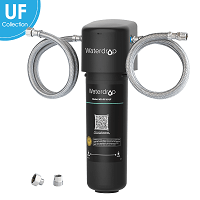
|
Key Features:
- Advanced UF membrane
- Compact design
- Simple installation
- 4-stage filtration
- Less future replacement cost
|
|
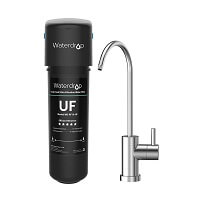
|
Key Features:
- Advanced UF membrane
- Lead-free stainless steel faucet
- Compact design
- Simple installation
- 4-stage filtration
- Less future replacement cost
|
Activated carbon water filtration
Activated carbon is derived from carbonaceous materials such as coal, coconut shell, bamboo, and wood. Unlike
regular carbon, activated carbon possesses small pores with a larger surface area. The raw carbon undergoes a
treatment process with hot gases to remove impurities and activate it.
The effectiveness of activated carbon is primarily due to its extensive surface area. This characteristic
enables it to efficiently filter out contaminants through physical absorption. Pollutants in the water are
attracted to the surface of the carbon, where they accumulate in the micron-sized gaps. The pores in activated
carbon are often likened to a parking lot, as they serve as spaces for contaminants to accumulate as water
passes through. The size of the pores determines the level of filtration, with smaller pores ensuring finer
filtration. The duration of contact between water and activated carbon surface also influences the filtration
process, with longer contact resulting in finer filtration. Hence, smaller activated carbon filters coupled with
low pressure yield the best filtration performance.
Activated carbon is effective in reducing contaminants such as pesticides, bacteria, suspended solids, heavy
metals, and more in water. The overall efficiency depends on the quality of the activated carbon used in the
filter. However, nearly all activated carbon filters can effectively reduce chlorine, regardless of quality.
Chlorine and chloramine are common water contaminants introduced during the filtration process at municipal
plants, and they are responsible for the distinct taste and odor in water.
|
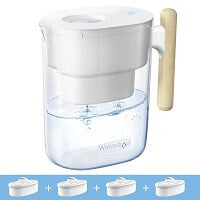
|
Key Features:
- Reduces 97.4% of chlorine
- NSF/ANSI 42 & 372 certified
- 5X filtration capacity
- Faster flow rate
- Smart life indicator
|
Reverse osmosis water filtration systems
Reverse osmosis (RO) is a technology specifically designed to eliminate a wide range of contaminants found in
source water. This process involves applying high pressure to force water molecules through a semi-permeable
membrane.
In reverse osmosis, the applied pressure surpasses the natural osmotic pressure, causing the water to move from
the high concentration side to the low concentration side. During this passage, only the molecules of pure water
are able to pass through the membrane, effectively trapping impurities and leaving us with purified water.
The reverse osmosis method is highly efficient and convenient, providing
contaminant-free water as the final result. It offers an economical alternative to purchasing bottled water,
ensuring clean water is readily available.
By employing a reverse osmosis water filtration system, up to 99% of contaminants
present in the water can be effectively removed. This includes substances like chlorine, fluorine, lead,
arsenic, cadmium, barium, radium, and chromium. Furthermore, the system can eliminate sulfates, nitrates, salts,
total dissolved solids (TDS), herbicides, pesticides, volatile organic compounds (VOCs), parasites, heavy
metals, rust, dirt, and sediments, among others.
|
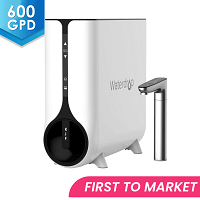
|
Key Features:
- 5-in-1 integrated filter
- 600 GPD flow rate
- 2:1 pure to drain rate
- 40-95℃ temperature range
- Smart display faucet
|
|
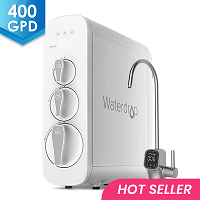
|
Key Features:
- NSF 58 & 372 certified
- 8-stage filtration
- 1:1 pure to drain ratio
- UV sterilization
- Smart display faucet
- Easy to install & replace
|
Conclusion
These filtration methods address the pressing concerns surrounding water pollution, including sewage incidents,
agricultural runoff, and industrial contaminants. By employing these technologies, we can mitigate the risks to
public health and protect our valuable ecosystems. Furthermore, these filtration systems offer cost-effective
and sustainable alternatives to buying bottled water, promoting environmental stewardship.
